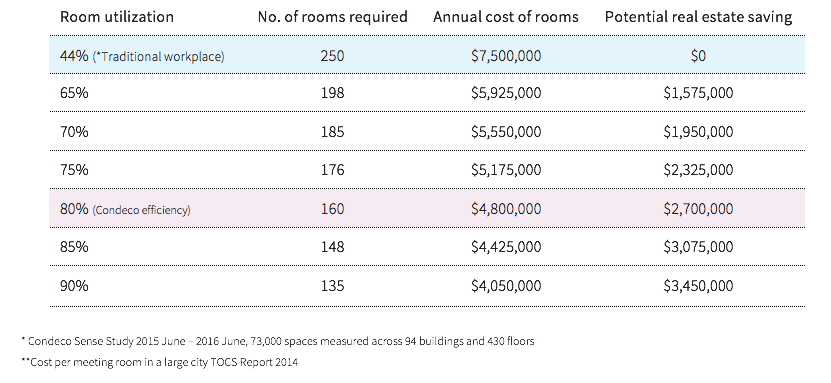Today the trend is for industry and thought leaders to transform companies into data-driven enterprises. Through technology, processes are streamlined and costs are reduced.
 Organizations want to understand what value and return on investment they are seeing from their assets. This has transformed the back office in areas such as hardware footprint and how organizations allocate their employee headcount. Condeco is enabling organizations to bring that data-driven mindset from the server room to the conference room and beyond. Let’s take a look at some of the ways agile organizations are ensuring their future success by leveraging data.
Organizations want to understand what value and return on investment they are seeing from their assets. This has transformed the back office in areas such as hardware footprint and how organizations allocate their employee headcount. Condeco is enabling organizations to bring that data-driven mindset from the server room to the conference room and beyond. Let’s take a look at some of the ways agile organizations are ensuring their future success by leveraging data.
{{cta(‘7039bddc-74d0-4e4c-bfa0-8e05bba54823’)}}
1. Treating Your Data as an Asset
Real estate professionals are interested in obtaining and analyzing data as a way of being more responsive to the business, enabling the data-driven approach that many businesses are looking to apply. John Anderson, Chief Revenue Officer at Condeco, spoke recently with CoreNet for their report “The Future of Corporate Real Estate.” These leaders are “… taking the thinking out of the game and giving people options to take back to the business. That is taking the big data concept to the next level.”
2. Utilizing Beacon Technology
Employees can interact with their workspace to ensure they have the resources needed to be productive. With this kind of workplace intelligence, organizations can ensure they are getting value out of their real estate by allowing unused workspace to be used by recently planned meetings. In the aforementioned report, John Anderson says: “We’re taking big data and leveraging it into the real-time or just-in-time office.” Organizations are using data they collect now to make informed decisions that will guide the future of their real estate resource allocation. “It is essentially freeing up that asset to use it, but also the employee is going to interact with real estate totally differently tomorrow than they do today,” Anderson says.
3. Having Instant Access to Data
Reduce your real estate cost and gain an accurate understanding of your space needs with Instant Access to data. Wireless sensors can capture data every 15 seconds that can be accessed instantly via any internet-enabled device. This data provides insight to drive real estate optimization.
4. Predictability Instead of Uncertainty
Do you really need a large conference room or could this space be better arranged for your needs? In “A 360-Degree View of Your Real Estate” on Globest.com, John Anderson notes, “You have a 20-person conference room, and we can provide data that tells you ‘you’ve only been averaging 8.6 people over the past 90 days, with a high of 10 and a low of one. Why do you have a 20-person conference room? Maybe you should have two 10s or four fives, or 10 cubicles and one 10-person conference room.’ Your asset, the real estate space, has provided you with a data set about itself that can now inform your business decisions. This leads to more efficient offices and cost savings. As noted in a Condeco Sense study from 2015, there is the potential for a significant cost savings when organizations realize the appropriate amount of real estate they require.

5. Work in Tomorrow’s Workplace Today
Make smarter decisions and change how your organization invests in workspace. In the future you will be able to draw on data from today to understand your evolving needs, thus cutting the costs of unused desks, rooms, and floors. In HP’s e-book “Welcome the machines: 10 ways tech and humans will shape the future of work”, Condeco COO Martin Booker discusses the innovative approach Condeco takes in transforming how enterprises think about their workspace. “At the moment, we are collecting data and reacting to the information provided. In 10 years’ time, it will be a much more predictive situation.”
Now is the time
The days of the real estate footprint being a static asset are in the past. Organizations moving forward will use data in all aspects of their business to justify and inform their spending decisions, with real estate expenses included. Now is the time to begin the data driven journey to the future.